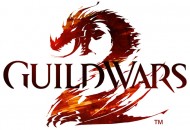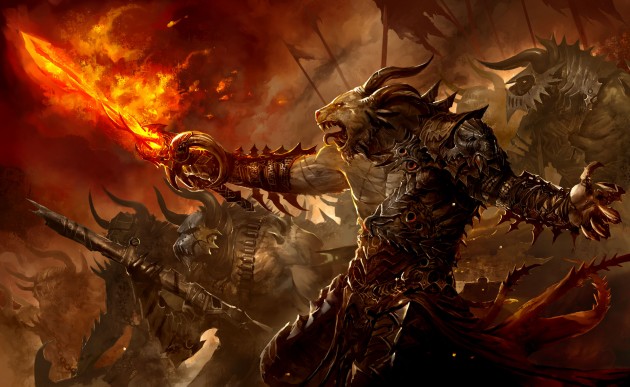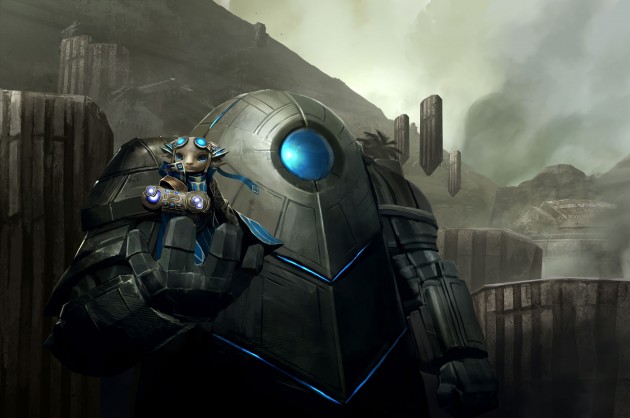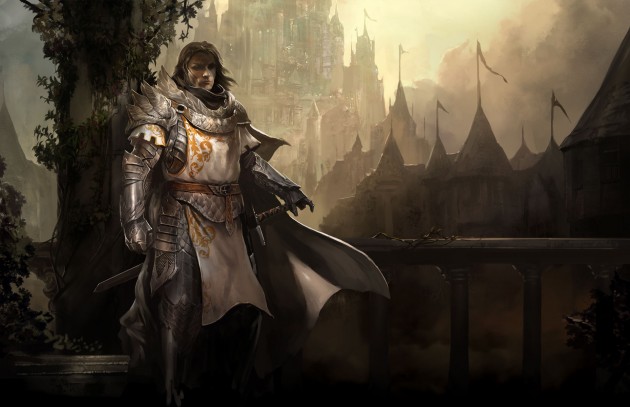I have heard, time and time again, the concerns and worries of players who have heard about—but not thoroughly looked into—Guild Wars 2. The complaints or concerns range from how much it is not like World of Warcraft to the individual development decisions and how players are concerned about the longevity of such a game in a vacuum. Since I have been reassuring (and pestering) several of my friends about for months, I’ll say it here:
Guild Wars 2 will be a glorious innovation that will be worth investing in and will have you coming back for more.
Servers, Factions, and Bears, Oh My!
The first concern that everyone seems to have is Player Versus Player (“PvP”). As many gamers know, most MMOs of late have featured some sort of opposed faction system that divides the player base. In the conflicts of these various titles, you are forced to choose side and contend with ridiculous barriers that prevent you from socializing with the other half of the game’s population. As games concerned with the theme of endless warring are wont to do, you are mechanically and narratively compelled to hate “the other guys”. For example, World of Warcraft’s famous Horde vs. Alliance factionalism transcends the game: players frequently (and heatedly) debate the merit of their faction outside of the game.
Guild Wars 2 solves this arbitrary and unnecessary hostility in several ways. First and foremost, Guild Wars 2 players are not pitted against the other players on their server in any way. For those whom the words “Stranglethorn Vale” incite rage, Guild Wars 2 will delight by segregating PvP from PvE. In fact, the game goes a step further to alleviate intra-faction competition by proportionally rewarding players, according to participation, a share of completed quests or events.
If rivalry is your bread and butter, then Guild Wars 2’s implementation of the Realm Versus Realm (RvR) mechanic heralds the reinvigoration of a fantastic PvP experience. Created for Dark Age of Camelot, an early rival to EverQuest, RvR provides for sprawling battles between players. Guild Wars 2 calls this “World Versus World,” or WvW, but the premise is the same: large-scale warfare that lasts two weeks at a time. The prizes for these contests include experience (promised to be granted at a rate on par with PvE), powerful items, or the ultimate prize of PvE buffs for a player’s “home server” for two weeks following a victory.
Even in the face of this incentivized competition, players are not artificially prevented from playing with their friends. Players can freely play their character on any other server, but a nominal fee is still required to migrate a character away from the server it was created on (the “home server”). If a player is happy with how frequently his or her character’s home server obtains the server-wide WvW bonuses, the player may never feel the need to migrate. World of Warcrafters, who have undoubtedly felt the pressure to transfer at one time or another (and lamented its cost), should take special notice.
The Raid at the End of the Tunnel
Players also frequently bemoan a lack of end-game content, or content that can be done once the game’s maximum character level is achieved. It is on this point that Guild Wars 2 diverges substantially from its competition, to the degree that this concern presents something of a false dilemma.
For those that are looking for that difficult task to embark on when the job is done, dungeons are the answer. These dungeons are promised to be challenging and rewarding adventures accompanied by stories that are dynamic to the decisions you make within them, as well as dynamic events that occur throughout the game world. Unlike the repetitive, grindy dungeons of other fantasy MMOs, these dungeons reward completion with a token that may be exchanged for a desired item. There will be no case of playing the same content over and over again hoping that one particular magic dagger drops at the end.
Further, I have spoken with many gamers who loved titles set in worlds of Dragon Age or Elder Scrolls. There is, however, a consensus on why they stopped playing: these worlds do not evolve and cannot be shared with friends. Guild Wars 2 creates an experience where you can share the work of your character again and again.
With respect to end-game content, a more genuine comparison for Guild Wars 2 would be an Elder Scrolls title that has been augmented with a persistent, evolving world and massively cooperative play. For seasoned MMO players weary of the formulaic raid model, this is a charming departure. For the seasoned RPG player that has been craving a bigger experience, perhaps the MMO genre is finally worth a look.
Last we must turn to ArenaNet, the developer behind the Guild Wars franchise, and the ultimate authority in these matters. In their own product FAQ, ArenaNet proposes that players think of their game as a Competitive Online Role-Playing Game, or CORPG.
“Guild Wars was designed from the ground up to create the best possible competitive role-playing experience. Success in Guild Wars is always the result of player skill, not time spent playing or the size of one’s guild.”
It’s as much a slam as it is a clarification.
Free to Play
Finally, Guild Wars 2 has occasionally suffered under the weight of its Free To Play (“F2P”) model, with many gamers using “Free To Play” as a slur meant to hastily dismiss an extremely varied model of financing an MMO. While it is true that historical F2P titles have been guilty of both nickel n’ diming its players and wanting for polish or support, Guild Wars 2 is refreshingly conscientious about and sensitive to these problems.
Fit and Finish
For the amount of work ArenaNet has already invested in Guild Wars 2, fearing a game plagued by rough edges seems unfounded. The obvious attention to detail and the rave previews should suffice to put this concern to rest. Most convincingly, the title’s release has long been gated by “when it’s ready”, the sign of a developer that cares more about the quality of its work than the pressure of a publisher.
Continued Support
In retrospect, we now understand that the freemium model employed by the original Guild Wars was a precursor for the model to be used by Guild Wars 2—a reassuring conclusion. Seven years on, many of those spent slaving away on a sequel, ArenaNet is still creating and releasing a flood of free content for Guild Wars. It’s clear that the designers aren’t only trying to make money; they are trying to create something they can be proud of. AHTV5-KQ2YF-RHIBF.
Cash Money
A final point about Guild Wars 2’s particular implementation of the F2P model is that real money can be used to buy tradable gems. These gems can then be used as a currency to purchase in-game perks, or may simply be traded to other players for gold. This mechanism provides an avenue for players to obtain these gems, and this aspect of the game, without exchanging hard currency. This fair approach is topped off by ArenaNet’s firm declaration that no items purchased with hard currency can be used as an in-game advantage. In this case, it’s clear that items will be matters of vanity or convenience.
 Countdown to Launch
Countdown to Launch
As you can see, Guild Wars 2 fights a raft of misconceptions from today’s MMO players—to say nothing of the challenges it faces with Star Wars: The Old Republic and World of Warcraft, which continue to dominate the landscape. Even so, Guild Wars 2 has the chops to take this repetitive market in a new and inspired direction: a division of labor in PvE and PvP, mobility across servers, more than a splash of co-op RPG and an egalitarian funding model, just to name a few.
With pre-orders and digital pre-sales now available, the perfect start to a new era of persistent world gaming is, at long last, upon us.


























 Articles RSS
Articles RSS